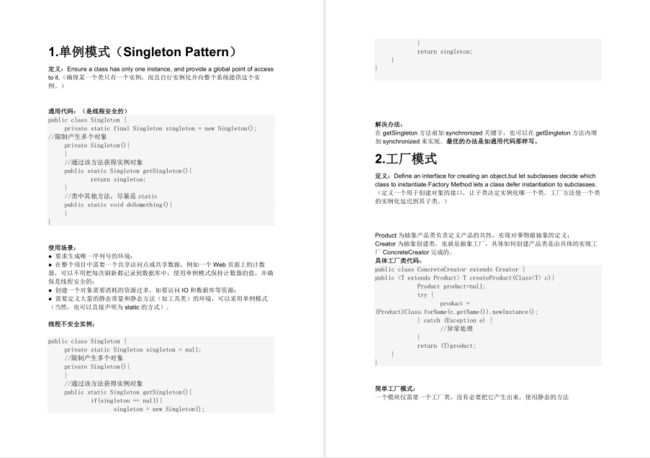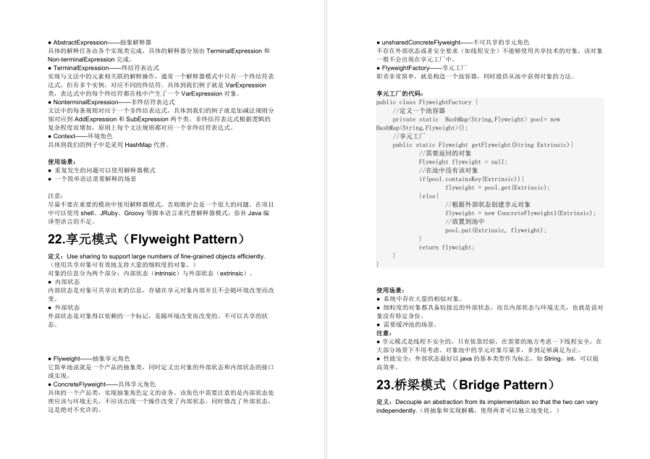这份阿里大牛精心整理的设计模式学习笔记,定能让你面试一通百通
设计模式是个好东西,能够给我们带来各种好处,比如降低对象之间的耦合,增加程序的可复用性、可扩展性、可维护性等等。
本文将先介绍23种设计模式,然后展出一些知识要点,解析分享,面试专题。
23种设计模式
1. 单例模式(Singleton Pattern )
定义:Ensure a class has only one instance, and provide a global point of access to it.(确保某一个类只有一个实例,而且自行实例化并向整个系统提供这个实例。)
2. 工厂模式
定义:Define an interface for creating an object,but let subclasses decide which class to instantiate.Factory Method lets a class defer instantiation to subclasses.(定义一个用于创建对象的接口,让子类决定实例化哪一个类。工厂方法使一个类的实例化延迟到其子类。)
3. 抽象工厂模式(Abstract Factory Pattern )
定义:Provide an interface for creating families of related or dependent objects without specifying their concrete classes.(为创建一组相关或相互依赖的对象提供一个接口,而且无须指定它们的具体类。)
4. 模板方法模式(Template Method Pattern )
定义:Define the skeleton of an algorithm in an operation,deferring some steps to subclasses.Template Method lets subclasses redefine certain steps of an algorithm without changing the algorithm's structure.(定义一个操作中的算法的框架,而将一些步骤延迟到子类中。使得子类可以不改变一个算法的结构即可重定义该算法的某些特定步骤。)
5. 建造者模式(Builder Pattern )
定义:Separate the construction of a complex object from its representation so that the same construction process can create different representations.(将一个复杂对象的构建与它的表示分离,使得同样的构建过程可以创建不同的表示。)
6. 代理模式(Proxy Pattern )
定义:Provide a surrogate or placeholder for another object to control access to it.(为其他对象提供一种代理以控制对这个对象的访问。)
7. 原型模式(Prototype Pattern )
定义:Specify the kinds of objects to create using a prototypical instance,and create new objects by copying this prototype.(用原型实例指定创建对象的种类,并且通过拷贝这些原型创建新的对象。)
8. 中介者模式
定义:Define an object that encapsulates how a set of objects interact.Mediator promotes loose coupling by keeping objects from referring to each other explicitly,and it lets you vary their interaction independently.(用一个中介对象封装一系列的对象交互,中介者使各对象不需要显示地相互作用,从而使其耦合松散,而且可以独立地改变它们之间的交互。)
9. 命令模式
定义:Encapsulate a request as an object,thereby letting you parameterize clients with different requests,queue or log requests,and support undoable operations.(将一个请求封装成一个对象,从而让你使用不同的请求把客户端参数化,对请求排队或者记录请求日志,可以提供命令的撤销和恢复功能。)
10. 责任链模式
定义:Avoid coupling the sender of a request to its receiver by giving more than one object a chance to handle the request.Chain the receiving objects and pass the request along the chain until an object handles it.(使多个对象都有机会处理请求,从而避免了请求的发送者和接受者之间的耦合关系。将这些对象连成一条链,并沿着这条链传递该请求,直到有对象处理它为止。)
11. 装饰模式(Decorator Pattern )
定义:Attach additional responsibilities to an object dynamically keeping the same interface.Decorators provide a flexible alternative to subclassing for extending functionality.(动态地给一个对象添加一些额外的职责。就增加功能来说,装饰模式相比生成子类更为灵活。)
12. 策略模式(Strategy Pattern )
定义:Define a family of algorithms,encapsulate each one,and make them interchangeable.(定义一组算法,将每个算法都封装起来,并且使它们之间可以互换。)
13. 适配器模式(Adapter Pattern )
定义:Convert the interface of a class into another interface clients expect.Adapter lets classes work together that couldn't otherwise because of incompatible interfaces.(将一个类的接口变换成客户端所期待的另一种接口,从而使原本因接口不匹配而无法在一起工作的两个类能够在一起工作。)
14. 迭代器模式(Iterator Pattern )
定义:Provide a way to access the elements of an aggregate object sequentially without exposing its underlying representation.(它提供一种方法访问一个容器对象中各个元素,而又不需暴露该对象的内部细节。)
15. 组合模式((Composite Pattern) )
定义:Compose objects into tree structures to represent part-whole hierarchies.Composite lets clients treat individual objects and compositions of objects uniformly.(将对象组合成树形结构以表示“部分-整体”的层次结构,使得用户对单个对象和组合对象的使用具有一致性。)
16. 观察者模式(Observer Pattern )
定义:Define a one-to-many dependency between objects so that when one object changes state,all its dependents are notified and updated automatically.(定义对象间一种一对多的依赖关系,使得每当一个对象改变状态,则所有依赖于它的对象都会得到通知并被自动更新。)
17. 门面模式(Facade Pattern )
定义:Provide a unified interface to a set of interfaces in a subsystem.Facade defines a higher-level interface that makes the subsystem easier to use.(要求一个子系统的外部与其内部的通信必须通过一个统一的对象进行。门面模式提供一个高层次的接口,使得子系统更易于使用。)
18. 备忘录模式(Memento Pattern )
定义:Without violating encapsulation,capture and externalize an object's internal state so that the object can be restored to this state later.(在不破坏封装性的前提下,捕获一个对象的内部状态,并在该对象之外保存这个状态。这样以后就可将该对象恢复到原先保存的状态。)
19. 访问者模式(Visitor Pattern )
定义:Represent an operation to be performed on the elements of an object structure. Visitor lets you define a new operation without changing the classes of the elements on which it operates.(封装一些作用于某种数据结构中的各元素的操作,它可以在不改变数据结构的前提下定义作用于这些元素的新的操作。)
20. 状态模式(复杂)
定义:Allow an object to alter its behavior when its internal state changes.The object will appear to change its class.(当一个对象内在状态改变时允许其改变行为,这个对象看起来像改变了其类。)
21. 解释器模式(Interpreter Pattern )(少用)
定义:Given a language, define a representation for its grammar along with an interpreter that uses the representation to interpret sentences in the language.(给定一门语言,定义它的文法的一种表示,并定义一个解释器,该解释器使用该表示来解释语言中的句子。)
22. 享元模式(Flyweight Pattern )
定义:Use sharing to support large numbers of fine-grained objects efficiently.(使用共享对象可有效地支持大量的细粒度的对象。)
23. 桥梁模式(Bridge Pattern )
定义:Decouple an abstraction from its implementation so that the two can vary independently.(将抽象和实现解耦,使得两者可以独立地变化。)
知识要点
解析分享
面试专题
重要的事:需要领取完整版的设计模式学习笔记的话,请点赞+关注后私信“666”获取到免费的下载方式!







